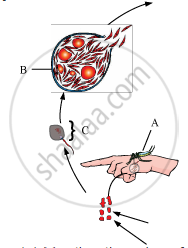Advertisements
Advertisements
Question
List the causative agent, mode of transmission and symptoms for Diphtheria and Typhoid.
Solution
| Diseases | Causative agent | Site of infection | Mode of transmission | Symptoms |
| Diphtheria | Corynebacterium diphtheriae | Larynx, skin, nasal and genital passage | Droplet infection | Fever, sore throat, hoarseness, and difficulty in breathing |
| Typhoid | Salmonella typhi | Intestine | Through contaminated food and water | Headache, abdominal discomfort, fever, and diarrhoea |
RELATED QUESTIONS
Study a part of the life cycle of malarial parasite given below. Answer the questions that follow:

(a) Mention the roles of ‘A’ in the life cycle of the malarial parasite.
(b) Name the event ‘C’ and the organ where this event occurs.
(c) Identify the organ ‘B’ and name the cells being released from it.
How does the transmission of the following disease take place?
Amoebiasis
Exo-erythrocytic schizogony of Plasmodium takes place in ____________.
The sporozoites of Plasmodium vivax are formed from ________.
Poliomyelitis which causes infantile paralysis enters the body through ____________.
The Athlete’s foot disease in human is caused by ____________.
Where do the following events in the life cycle of Plasmodium takes place?
a) Fertilization - _________
b) Development of gametocytes - __________
c) Release of sporozoites - ________
d) Schizogony - _________
Complete the following table:
| Diseases | Causative agent | Site of infection | Incubation period |
| Mumps | |||
| Chicken pox | |||
| Dengue fever |
What is Kala-azar?
A person is suffering from a high-grade fever. Which symptoms will help to identify if he/she is suffering from Typhoid, Pneumonia or Malaria?
Recognition of an antigenic protein of a pathogen or exposure to a pathogen occurs during many types of immune responses, including active immunity and induced active immunity.
Specify the types of responses elicited when human beings get encountered by a pathogen.
Leishmaniasis is a disease caused by a protozoan parasite transmitted by biting of ______.
A major reason for studying human aging is that:
The alveoli (air filled sacs) of the lungs are infected in
A person with sickle cell anemia is ______.
The following table shows certain diseases, their causative organisms and symptoms. Fill the gaps.
| Name of the Disease | Causative organism | Symptoms | |
| (i) | Ascariasis | Ascaris | ______ |
| (ii) | ______ | Trichophyton | Appearance of dry, scaly lesions on various parts of the body |
| (iii) | Typhoid | ______ | High fever, weakness, headache, stomach pain, constipation. |
| (iv) | Pneumonia | Streptococcus pneumoniae | ______ |
| (v) | ______ | Rhino viruses | Nasal congestion and discharge, sorethroat, cough, headache |
| (vi) | Filariasis | ______ | Inflammation in lower limbs |
Ringworm is one of the most common infectious fungal disease in humans. state any of its two symptoms.
A patient complains of suffering from constipation, stomach ache, stool with blood clots and excess mucous. The physician diagnosed it as amoebiasis, after stool test.
- Write the scientific name of the microbe identified in the stool sample.
- How do you think, the patient must have contracted it?
- Write your suggestions to the patient to avoid infection in future.
Write the scientific name of the causative agent of the following diseases:
Typhoid
How does the transmission of the following disease take place?
Pneumonia
